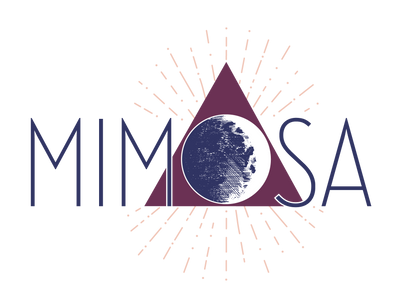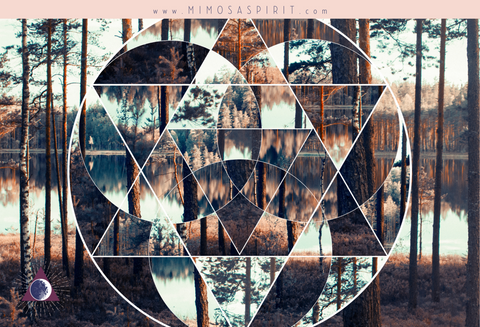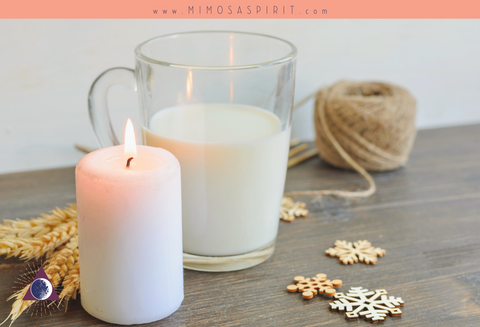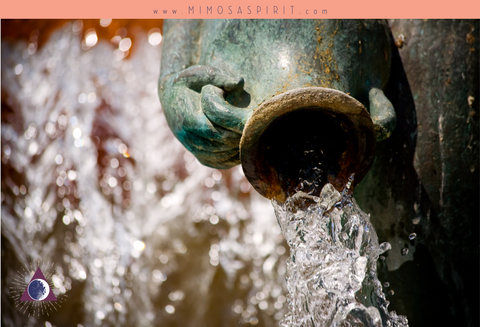
Ostara & The Wheel of the Year
By Ashley Leavy
One way that I like to connect with the seasons and cycles of the earth is by tuning into The Wheel of the Year. This is a relatively new practice for me, but I'm finding the journey into exploring this way of being in flow with the seasons to be an enjoyable one.
The Wheel of the Year can help you tune into natural cycles (similar to the Lunar Phases - but on an annual scale rather than just monthly) and helps you internalize these outward changes in nature as reflections of the growth and evolution you experience in your own life. Living in harmony with the seasons and the ebb and flow of nature helps you to lead a more soulful life and to cultivate a deeper understanding of yourself on a soul level. The Wheel of the Year helps you recognize who you are and your role in the world around you.
So What is the Wheel of the Year?
Separated into 8 main holidays, the Wheel of the Year is a representation of seasonal cycles that focuses on the 4 Solar Holidays of the year (also known as the quarter days). This stems from the Anglo-Saxon cultural observations of the solstices and equinoxes, with the addition of the 4 Gaelic, agrarian, seasonal celebrations (the mid-points between the solar holidays known as the lunar cross-quarter days or fire festivals).
Although some of the holidays observed in the Wheel of the Year are quite old, The Wheel of the Year as a whole is fairly modern (being developed in the late 1950s). Though I don't personally follow the tradition that created the contemporary Wheel of the Year, I do find it a helpful way to think about the passage of time and what's happening in the world at each time of year.
I tend to identify more with the Gaelic Cross-Quarter Days, as they stem from my ancestral heritage, than I do with the Anglo-Saxon solstices and equinoxes, but I do find value in these quarter days because they more closely align with the seasons as I observe them where I live in Madison, Wisconsin. For example, though my ancestors in Ireland and Scotland celebrated Imbolc as the beginning of Spring, I don't quite feel things awakening until the time of Ostara, the Spring Equinox, here in the United States. For this reason, these seasonal markers are important for helping me feel connected to what's happening in nature all year long, while the cross-quarter days hold more spiritual significance for me in other ways.

An Introduction to Ostara:
Ostara, or the Spring Equinox here in the Northern Hemisphere, is the first of the quarter days, which marks the second of the spring holidays (the mid-point between Imbolc and Beltane). Ostara is traditionally celebrated on the day of the Vernal Equinox, determined by when the Sun is directly over the earth's equator (this date may range from March 19th through March 22nd each year depending on the Sun's position).
Modern Ostara celebrations stem from the contemporary Wheel of the Year, where Ostara is associated with the Spring Equinox and is celebrated as a time of new beginnings and the re-emergence of life after the depth of winter.
Ostara Crystals:
- Amethyst
- Aquamarine
- Green Aventurine
- Bloodstone
- Citrine
- Heliodor
- Eclipse Jasper
- Yellow Jasper
- Lepidolite
- Moonstone
- Morganite
- Pink Opal
- Golden Quartz
- Rose Quartz
- Rhodonite
Ostara Signifies the Time for:
- Abundance
- Renewal
- Fertility
- Growth
- Balance
- Joy
- New beginnings & change
- Taking action
- Blessings
- Light
- Celebrating the return of all things green
- The coming of Spring
- Rebirth

Why Celebrate Ostara?
Ostara welcomes in the Spring, the return of longer days, and the renewal of the land. At this time, plants and animals are beginning to wake up from their winter slumber, and nature seems to come alive as the earth begins to warm. As the land thaws from its winter freeze, seeds can be sown, new crops can be planted, birds and bees return to the sky, and livestock born at Imbolc are growing and being reared by their mothers.
Ostara is celebrated at the Vernal Equinox, when light and darkness are equal, which means that from this day forward, the days will continue to lengthen until the time of the Summer Solstice. For this reason, Ostara is a celebration of the Sun, of the dawn, and of the return of radiant light.
Ways to Celebrate Ostara:
- Feasts are a common way to celebrate Ostara
- Dye or paint eggs and use them for an egg hunt or an egg-rolling race (you can use hard-boiled or wooden eggs)
- Create a bouquet of Spring flowers and place it on your altar or in your home (gather them only from places where you have permission, take only what you need and leave much more than you take)
- Bake fresh bread or hot cross buns
- Prepare a salad with early spring greens (grown yourself or carefully foraged)
- Go on a walk or hike in nature and take some photos that capture the return of spring (you can even print these and put them on your altar or create some Ostara-themed Grimoire pages)
- Be intentional with your shadow work during this time of balanced light and darkness
- Create a nature altar for spring (add your items dedicated to nature, or collect natural items to add - only collect with permission & please be respectful)
- Plan your garden or start vegetable seeds
- Spring cleaning & home blessing
- Enjoy the delicious treat of some honey or honeycomb
Ostara and the Goddess Eostra:
Eostra is a Germanic Goddess (also known as Eostre, Eastre, or Ostara) for whom Ostara is named. The only recorded account of this Goddess comes from the Venerable Bede's "The Reckoning of Time." Bede claimed that Anglo-Saxon Pagans held feasts in Eostra's honor during Ostarmanoth (the equivalent of the month of April).
Though the authenticity of Bede's account is hotly contested, some historical linguists connected the Goddess Eostra to the Proto-Indo-European goddess of the dawn, Hewsos/Hausos/Heusos. Historical connections between the goddess Eostra and Germanic Easter customs and connections with hares and eggs are also debated among scholars, though they are widely celebrated by modern Pagans.
Other Ostara Goddesses, Gods, or Deities:
- Eostra/Eostre/Eastre/Ostara/Austro/Austra
- Blodeuwedd/Flower Face
- Artha
- Morgen Cliton of Avalon
- Eos (Greek Goddess of Dawn that Eostra may be attributed to)
- Ushas (Vedic Goddess of Dawn that Eostra may be attributed to)
- Aurora (Roman Goddess of Dawn that Eostra may be attributed to)
- Frig/Frige
- Freya
- Libera
- Persephone
- Demeter
- Thor
- Erce (Mother of the Earth)
- Rheda/Hretha/Hrethe/Hrede/Hruada/Hrouda
- Mother Mary (Lady Day/Feast of the Annunciation)
- Jesus (Easter)
- Mary Magdalene (Easter)
- The Maiden form of the Triple Goddess (Maiden Day)
- Cybele (Hilaria)
- Attis (Hilaria)
- Dísir (Dísablót)
- Valkyries (Dísablót)
Ostara Symbols:
- Hares & Rabbits
- Eggs
- Baskets
- Chicks
- Butterflies
- Tulips
- Daffodils
- Pansy Flowers
- Violet Flowers
- Lilac Flowers
- Strawberry Plants
- Honey & Honeycomb
- Bees
- Lambs & Other Baby Animals
- Robins & Other Birds
- Grass
- Seeds
- Rain
- Asparagus
- Radiant Light
Ostara Herbs:
- Alder
- Apple Blossom
- Broom
- Catnip
- Cleavers
- Cornflower
- Dill
- Hawthorn
- Irish Moss
- Lavender
- Lemongrass
- Meadowsweet
- Spearmint
- Sweet Woodruff
Ostara Colors:
- Pink
- Yellow
- Lavender
- Green
Ostara is also known as (or is related to):
- Spring Equinox/Vernal Equinox (Determined by when the sun is directly over the Earth's equator - sometime between March 19th-22nd each year)
- Eostra's Day (Observed on the Spring Equinox)
- Easter (Observed on the first Sunday after the first Full Moon following the Spring Equinox)
- Rites of Spring (Observed on the day of the Spring Equinox)
- Lady Day/Feast of the Annunciation (March 25th)
- Maiden Day (Observed on the Spring Equinox)
- Alban Eilir/The Light of the Earth (Observed on the Spring Equinox)
- Hilaria (March 15th-28th, but March 25th was the most significant)
- Dísablót (Likely observed on the Spring Equinox)
Suggested Reading:
- Ostara: Rituals, Recipes, & Lore for the Spring Equinox (Llewellyn’s Sabbat Essentials Series)
- Ostara Tarot
- Ostara: Customs, Spells, & Rituals for the Rites of Spring
- Eostre Ostara Eostar: Facts, Assumptions, Conjectures, Speculations, Guesses, and Nonsense
*If you live in the Southern Hemisphere, you'll be celebrating the festival of Mabon today instead of Ostara to keep with the seasonal cycles. In the Southern Hemisphere, Ostara is usually celebrated during the time of the Northern Hemisphere's Autumnal Equinox.






0 comments